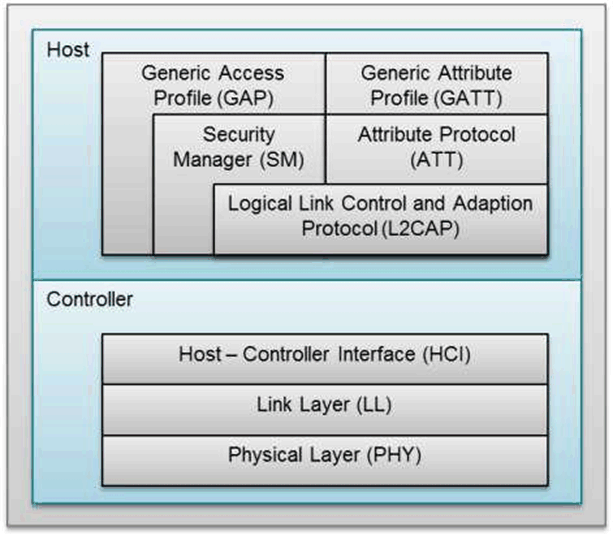SWRA654A December 2019 – April 2020 CC2652R , CC2652R7 , CC2652RSIP
3.3 Bluetooth
Bluetooth is a wireless communications system operating at 2.4 GHz. There are two wireless Bluetooth technologies within the same specification: Bluetooth Classic and Bluetooth Low Energy. Although both technologies partly share the same name, they are not compatible, which means that a Classic device cannot directly communicate with a Low Energy device. This document only covers Bluetooth Low Energy. For more information about Bluetooth Classic, see the Bluetooth Core Specification.
A device operates in one of the four roles defined by the Bluetooth Core Specification: Broadcaster, Observer, Peripheral, and Central. The Broadcaster and Observer are non-connectable, which means that they cannot connect with any device. The Broadcaster broadcasts data without knowing if another device is receiving the data. The Observer listens to the data transmitted from Broadcasters without creating a link between the devices. The Peripheral and Central are connectable, which means that they will not share data before establishing a connection first. The Central can connect to multiple Peripherals to receive data.
The Bluetooth Low Energy protocol stack consist of the host and the controller, see Figure 5. The lower layers are located in the controller, and the higher layers are in the host. The application sits on top of the host. For more information about the different layers and the Bluetooth Low Energy stack, see the BLE5-Stack User's Guide.
 Figure 5. Bluetooth Low Energy Protocol Stack
Figure 5. Bluetooth Low Energy Protocol Stack Angle of arrival (AoA) is a direction-finding technique specified in the Bluetooth Core Specification that finds the angle from the receiver to the transmitter to create a basis for triangulation. The technique uses a well-defined antenna array to notice small changes in the path length between each antenna. The AoA packets must contain a section of a constant tone where there are no phase shifts that are caused by modulation. In a 2D scenario, the possible locations seen by one device is a straight line. As seen in Figure 6, a single intersection point can be determined using only two devices.
 Figure 6. Triangulation Using Connected AoA
Figure 6. Triangulation Using Connected AoA AoA is a part of the Real-Time Localization System (RTLS) Toolbox. Because of the inherent flexibility of the CC26x2 RF Core, RTLS features and security can be added without a significant impact on cost and energy consumption with no increase in peak power. Currently, AoA is only supported for connected devices: Peripheral and Central. Future implementations will make it possible to use non-connectable devices: Broadcaster and Observer. For more information about the RTLS Toolbox and AoA, see the BLE5-Stack User's Guide.
Because the Low Energy aspect of Bluetooth Low Energy is achieved by letting the device go to sleep when it is not transmitting or receiving packets, it is ideal to use for applications sending or receiving data infrequently, for example, sensors. Beacons can be used as sensors, for example, asset or personnel tracking, making sure that valuable assets are not lost or misplaced or that there is not overlap or deficiency of personnel. For more information, see Bluetooth low energy Beacons. Additional sensors can also be used to track ambient data such as temperature, detecting smoke, and so forth. The Sensor Controller, an ultra-low power 16-bit CPU core, should be used to achieve the lowest possible power consumption for sensor applications. It runs independently of the rest of the system, allowing the main MCU to sleep while the sensor controller is reading and processing sensor data. For more information about the sensor controller, see Meet the SimpleLink Sensor Controller and CC26xx, CC13xx Sensor Controller Studio.
The majority of Smartphones has support for Bluetooth Low Energy, making it suitable for applications that require user interaction or the ability to detect nearby devices. Example applications are detecting nearby Smartphones to send information to, identifying a specific device, and so forth.